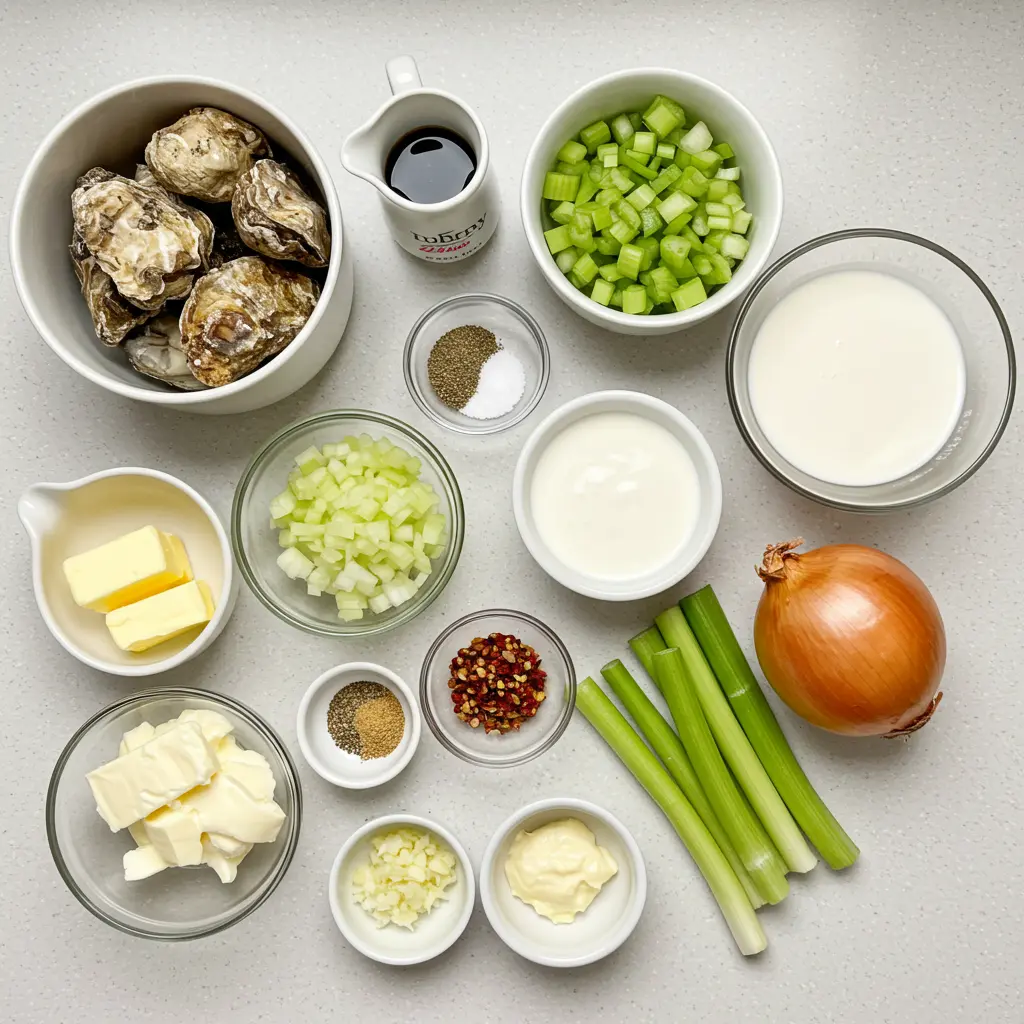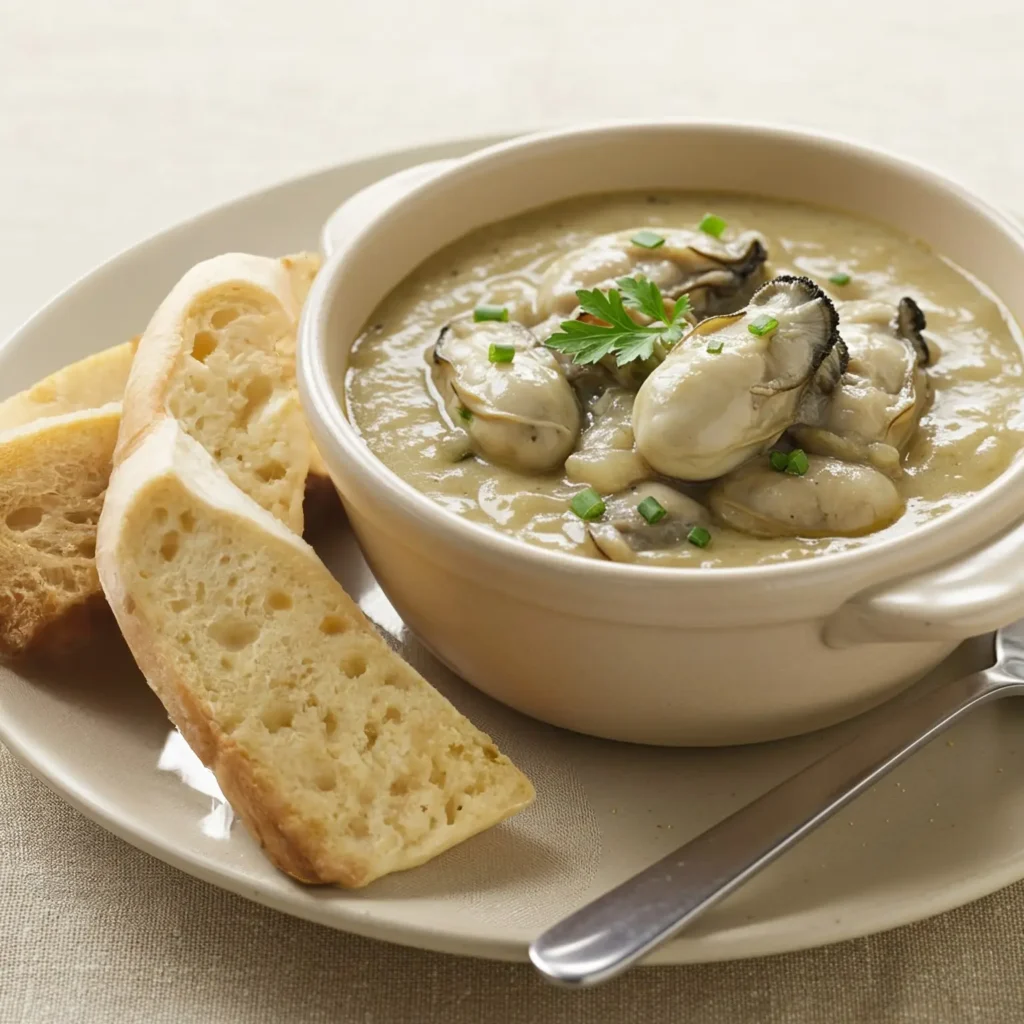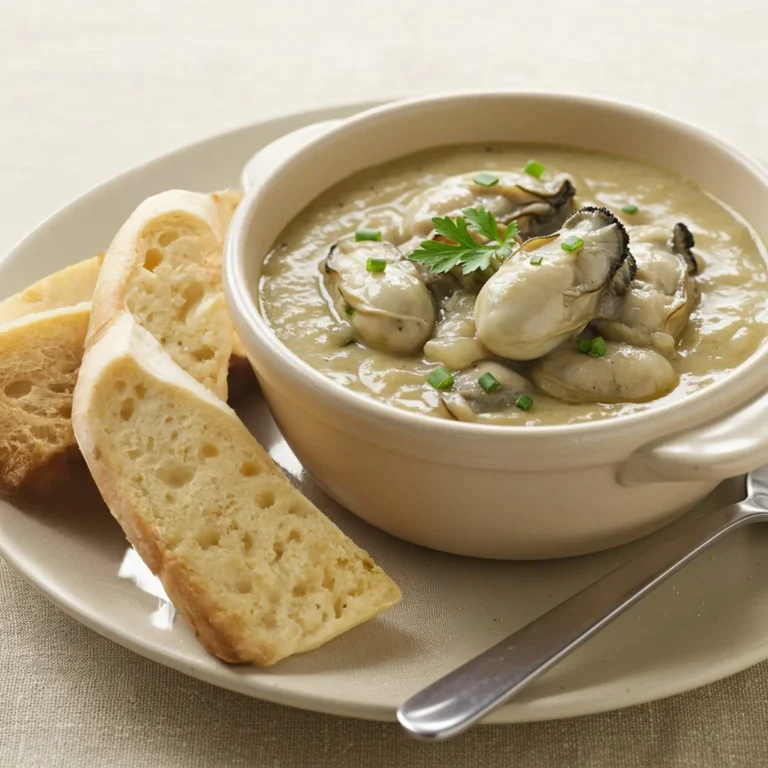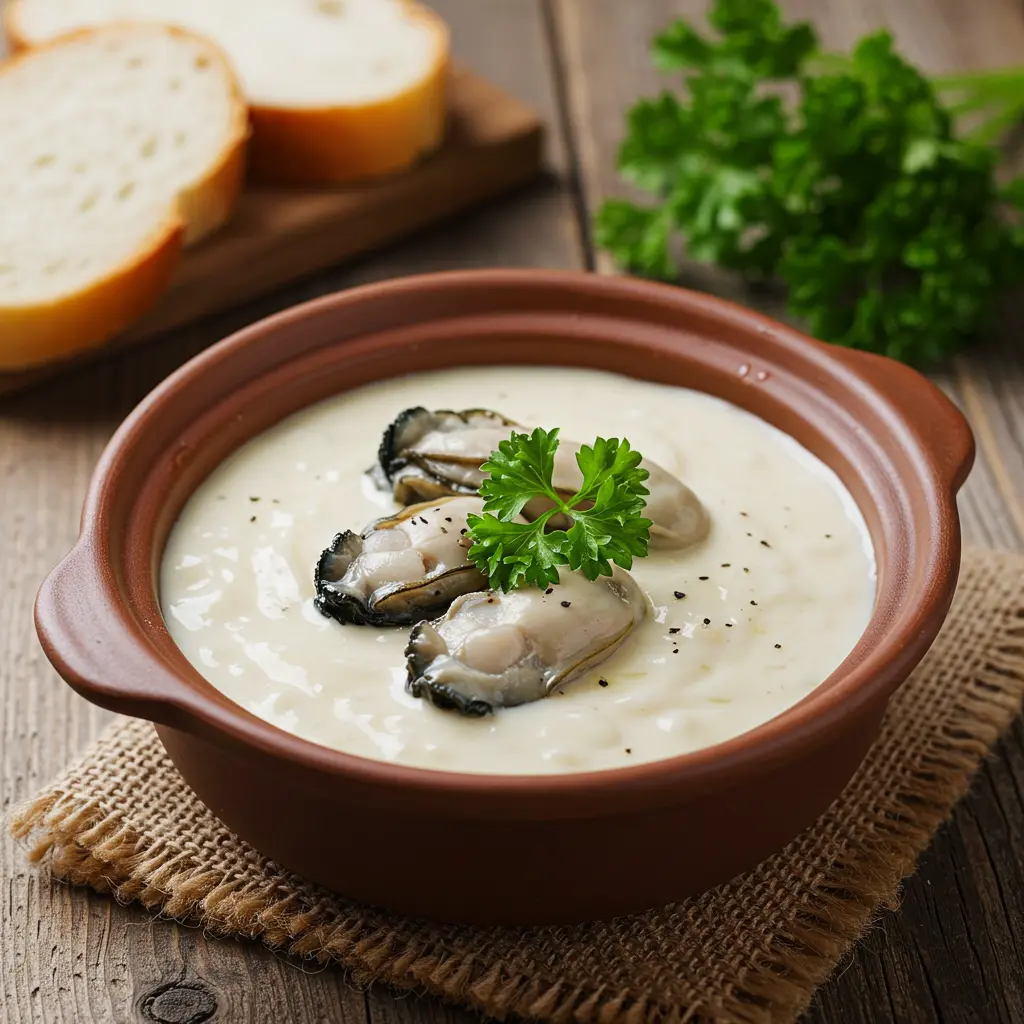Introduction
Oyster stew is a beloved dish that has warmed hearts and kitchens for generations. Known for its creamy texture and rich flavor, this comforting seafood stew showcases the delicate taste of fresh oysters. Whether enjoyed on a chilly evening or served at a festive gathering, it evokes warmth and nostalgia. In this article, we will explore various aspects of this classic dish, including traditional recipes, creative variations, and helpful tips for perfecting it. From straightforward preparations to more elaborate versions, there’s something for every seafood lover. Join us as we delve into the world of oyster stew and discover how to make this timeless recipe a staple in your culinary repertoire.
Understanding Oyster Stew
History of Oyster Stew
Oyster stew boasts a rich history that dates back to the early days of American coastal living. Originally, this dish was a way for fishermen and their families to utilize the abundant oyster harvests found along the Atlantic and Gulf coasts. The simplicity of the ingredients—oysters, milk, butter, and seasonings—allowed for quick preparation, making it a popular choice for families. Over time, this seafood dish evolved, incorporating regional flavors and variations, particularly in Southern cuisine. Today, it stands as a symbol of comfort food, often enjoyed during holiday gatherings and special occasions.
Nutritional Benefits of Oysters
Oysters are not only delicious but also packed with numerous health benefits. They are an excellent source of high-quality protein, making them a fantastic addition to a balanced diet. Rich in essential vitamins and minerals, these shellfish provide significant amounts of zinc, vitamin B12, and omega-3 fatty acids. Zinc is crucial for immune function, while vitamin B12 is vital for nerve health and the production of red blood cells. Additionally, the omega-3 fatty acids found in oysters contribute to heart health and may help reduce inflammation in the body. Including oysters in your meals can enhance your nutritional intake while enjoying a flavorful experience.
Ingredients for Oyster Stew

When it comes to making a delicious oyster stew, the quality and freshness of the ingredients are paramount. This part will guide you through the essential components needed to create a flavorful and comforting oyster stew. We’ll explore each ingredient, its purpose, and how to select the best options for your dish.
Key Ingredients for a Delicious Oyster Stew
- Fresh Oysters
- Description: The star of the dish, fresh oysters provide the unique briny flavor that defines oyster stew. When selecting oysters, look for those that are plump and have a clean, ocean-like scent. Avoid any that have a strong fishy smell or are open and unresponsive.
- Tip: If possible, buy oysters from a reputable seafood market or directly from a local fishmonger to ensure freshness.
- Heavy Cream
- Description: Heavy cream adds richness and a velvety texture to the stew. It balances the brininess of the oysters and enhances the overall flavor. You can also use half-and-half for a lighter option, but heavy cream is recommended for the best results.
- Tip: For a slightly different flavor, consider using coconut cream as a dairy-free alternative.
- Butter
- Description: Butter is used to sauté the vegetables and adds a rich, buttery flavor to the stew. It helps to create a base for the stew that complements the oysters beautifully.
- Tip: Use unsalted butter to control the saltiness of the dish, allowing you to season to taste.
- Onion
- Description: Chopped onion provides a sweet and aromatic base for the stew. It caramelizes when sautéed, adding depth to the flavor profile.
- Tip: Yellow or sweet onions work well in this recipe, but feel free to experiment with shallots for a more delicate flavor.
- Garlic
- Description: Fresh garlic adds a punch of flavor that elevates the dish. It pairs wonderfully with the oysters and enhances the overall taste of the stew.
- Tip: Mince the garlic finely to ensure it distributes evenly throughout the stew.
- Celery
- Description: Diced celery adds a subtle crunch and fresh flavor to the stew. It also contributes to the aromatic base when sautéed with onions and garlic.
- Tip: For a more robust flavor, use the inner leaves of the celery as well.
- Black Pepper and Salt
- Description: These seasonings enhance the flavors of the stew without overpowering the natural taste of the oysters. Adjust the seasoning to your preference.
- Tip: Freshly ground black pepper will provide a more intense flavor compared to pre-ground.
- Fresh Parsley
- Description: Chopped fresh parsley is used as a garnish, adding a pop of color and freshness to the finished dish. It complements the richness of the stew.
- Tip: Consider using other fresh herbs like chives or dill for a different flavor profile.
Optional Ingredients to Enhance Your Oyster Stew
- White Wine: A splash of dry white wine can add acidity and depth to the stew. It’s best to add it after sautéing the vegetables and before adding the cream.
- Hot Sauce: If you enjoy a bit of heat, a few dashes of your favorite hot sauce can elevate the flavors and add a spicy kick.
- Old Bay Seasoning: For a classic seafood flavor, consider adding a pinch of Old Bay seasoning to the stew as it cooks.
With these ingredients in hand, you’re well on your way to creating a delicious oyster stew. Remember, the key to a great stew lies in the freshness of your ingredients and the care you take in preparing them. In the next part, we will dive into the essential cooking techniques that will help you bring all these flavors together in perfect harmony.
Cooking Techniques for Oyster Stew
Cooking oyster stew is a straightforward process that combines sautéing, simmering, and finishing with cream. In this section, we will break down the steps to ensure you achieve the perfect balance of flavors and textures.

Step-by-Step Cooking Instructions
- Sauté the Aromatics
- In a large pot, melt butter over medium heat. Add chopped onions, minced garlic, and diced celery. Sauté until the vegetables are soft and fragrant, about 5-7 minutes.
- Add the Oysters
- Gently fold in the fresh oysters and their liquor (the liquid inside the shells). Cook for 2-3 minutes until the oysters begin to curl at the edges.
- Incorporate the Cream
- Pour in the heavy cream, stirring to combine. Bring the mixture to a gentle simmer, allowing it to thicken slightly. Season with salt and freshly ground black pepper to taste.
- Final Touches
- Remove the pot from heat and stir in freshly chopped parsley. For added flavor, consider a splash of white wine or a few dashes of hot sauce.
Tips for Cooking Oyster Stew
- Avoid Overcooking: Oysters cook quickly, so be careful not to overdo it. They should be just cooked through and tender.
- Adjust Consistency: If the stew is too thick, add a little seafood stock or water to reach your desired consistency.
- Taste as You Go: Always taste your stew as you cook. Adjust seasoning and flavors according to your preference.
Now that you know how to cook oyster stew, you’re ready to bring the flavors together in a warm, comforting dish. Next, we’ll cover serving suggestions that will make your oyster stew not only delicious but visually appealing as well.

Pairing Oyster Stew with Sides and Beverages
Ideal Side Dishes for Oyster Stew
When serving oyster stew, the right side dishes can enhance the overall dining experience. Traditional accompaniments include crusty bread or oyster crackers, which are perfect for dipping into the creamy stew. A simple green salad dressed with a light vinaigrette can provide a refreshing contrast to the richness of the stew. Additionally, coleslaw is a great option, as its crunch and acidity help balance the flavors. For a heartier meal, consider serving the stew with a side of roasted vegetables or a baked potato, which can complement the dish without overpowering it.
Beverage Pairings for Oyster Stew
Selecting the right beverages to accompany oyster stew can elevate your meal. For those who enjoy wine, a crisp white wine like Sauvignon Blanc or a light-bodied Chardonnay pairs beautifully with the dish. These wines enhance the flavors of the oysters without overwhelming them. If you prefer beer, opt for a light lager or a wheat beer, which can provide a refreshing contrast to the creamy stew. For non-alcoholic options, consider serving a sparkling water with a slice of lemon or a light herbal iced tea. These beverages can cleanse the palate and enhance the overall dining experience.
Serving Suggestions
When it comes to serving oyster stew, presentation is key. Use wide, shallow bowls to allow the stew to be the star of the meal. Garnish each serving with a sprinkle of freshly chopped herbs, such as parsley or chives, to add a pop of color and freshness. Consider offering additional toppings on the side, such as hot sauce or lemon wedges, so guests can customize their bowls to their liking. Creating a warm and inviting atmosphere with soft lighting and comfortable seating can also enhance the dining experience, making your meal memorable.
Health Considerations and Dietary Restrictions
Health Benefits of Oyster Stew
Oyster stew is not only a delicious comfort food but also offers various health benefits. As mentioned earlier, oysters are rich in essential nutrients, including zinc, vitamin B12, and omega-3 fatty acids. These nutrients contribute to improved immune function, enhanced brain health, and better heart health. The creamy base of the stew, often made with milk or cream, provides calcium and vitamin D, which are vital for bone health. Additionally, the dish can be a low-calorie option depending on the ingredients used, making it suitable for those looking to maintain a balanced diet.
Dietary Restrictions and Modifications
For those with dietary restrictions, oyster stew can be modified to accommodate various needs. If someone is lactose intolerant, consider using lactose-free milk or a plant-based cream alternative, such as coconut milk or almond milk, to maintain the creamy texture. For a gluten-free option, ensure that any seasonings or accompaniments, like crackers, are gluten-free. Additionally, individuals following a vegetarian or vegan diet can create a similar stew using mushrooms or other vegetables as a substitute for oysters, while still incorporating the creamy base. These modifications allow everyone to enjoy a delicious bowl of stew, regardless of dietary preferences.
Allergen Awareness
When preparing oyster stew, it’s essential to be aware of potential allergens. Oysters themselves are a common allergen, and individuals with shellfish allergies should avoid this dish entirely. Additionally, be cautious with added ingredients like butter or cream, as some individuals may have dairy allergies or intolerances. Always check with guests about their dietary restrictions before serving, and consider providing ingredient lists to ensure everyone can enjoy the meal safely. Being mindful of allergens promotes an inclusive dining experience for all.
Oyster Stew in Different Cultures
Regional Variations of Oyster Stew
Oyster stew is a beloved dish that varies significantly across different regions, each bringing its unique twist to the recipe. In the Southern United States, particularly in Louisiana, oyster stew often incorporates Cajun spices and vegetables, such as bell peppers and onions, creating a flavorful and hearty version. In New England, the stew is typically simpler, focusing on the natural flavors of the oysters with minimal seasoning and often served with a side of saltines. Meanwhile, in coastal areas of the Pacific Northwest, chefs may add local ingredients like wild mushrooms or herbs to enhance the dish’s complexity.
International Takes on Oyster Stew
Beyond the United States, oyster stew has inspired various international interpretations. In France, for example, a dish called “Bouilli” features oysters cooked in a rich broth with cream and herbs, showcasing the French culinary flair for combining seafood with rich flavors. In Japan, oysters are often used in miso soup, where they are simmered in a savory broth with seaweed and tofu, offering a completely different taste experience. These international variations highlight the versatility of oysters and how they can be adapted to fit various culinary traditions.
Celebrating Cultural Traditions
Oyster stew is not just a dish; it often plays a role in cultural celebrations and traditions. In many coastal communities, oyster stew is a staple during holiday gatherings, especially around Christmas and New Year’s. Families often have their own cherished recipes passed down through generations, making the dish a symbol of family heritage. In some cultures, oysters are believed to bring good luck, making them a popular choice for celebratory meals. Understanding the cultural significance of oyster stew can deepen appreciation for this dish and its place in various culinary traditions.
Cooking Oyster Stew: Mistakes to Avoid
Common Mistakes When Making Oyster Stew
When preparing oyster stew, there are several common pitfalls that can detract from the final dish. One major mistake is overcooking the oysters. Oysters should be added towards the end of the cooking process and only cooked until they just curl. Overcooking can lead to a rubbery texture, which is unappetizing. Another frequent error is failing to season properly. Since oysters are naturally briny, it’s essential to balance the flavors with the right amount of salt and pepper. Taste the stew as it cooks to ensure the seasoning is just right.
Using Low-Quality Ingredients
The quality of ingredients significantly impacts the outcome of your oyster stew. Using low-quality or stale oysters can lead to a disappointing dish. Always opt for fresh, high-quality oysters from a trusted source. Additionally, the cream or milk used should be fresh and of good quality, as this will enhance the overall flavor and texture of the stew. Avoid using pre-packaged or processed ingredients, as these can introduce unwanted flavors and detract from the dish’s authenticity.
Neglecting the Base Flavors
Creating a flavorful base is crucial for an outstanding oyster stew. Many cooks make the mistake of skipping the sautéing of aromatics like onions, garlic, or celery before adding the cream and oysters. This step builds depth and richness in the stew. Take the time to sauté these ingredients until they are soft and fragrant; this will elevate the overall flavor profile of your dish. Additionally, consider adding a splash of white wine or sherry to deglaze the pan after sautéing, which can add another layer of complexity to the stew.
Storing and Reheating Oyster Stew
Proper Storage Techniques
To ensure the longevity and safety of your oyster stew, proper storage techniques are essential. If you have leftover stew, allow it to cool to room temperature before transferring it to an airtight container. It’s best to store the stew in the refrigerator if you plan to consume it within a few days. Make sure to use the stew within 3 to 4 days for optimal freshness and flavor. For longer-term storage, consider freezing the stew. However, keep in mind that the texture of the oysters may change upon reheating, so it’s recommended to freeze the stew without the oysters and add them fresh when reheating.
Reheating Oyster Stew Safely
When reheating oyster stew, it’s important to do so gently to preserve the texture and flavor. Avoid using a microwave, as this can lead to uneven heating and overcooking of the oysters. Instead, reheat the stew on the stovetop over low to medium heat, stirring occasionally. If the stew has thickened while stored, you can add a splash of milk or cream to help restore its original consistency. Heat until the stew is warmed through, but be careful not to bring it to a boil, as this can toughen the oysters. Once heated, serve the stew immediately for the best taste and texture.
Reviving Leftover Oyster Stew
If you find that your leftover oyster stew has lost some of its flavor or richness, consider reviving it with a few simple additions. Adding a splash of fresh cream or a squeeze of lemon juice can brighten the flavors and enhance the overall taste. You might also add fresh herbs like parsley or chives just before serving to give it a fresh, vibrant touch. If you feel adventurous, consider incorporating other seafood, such as shrimp or crab, to add variety and richness to the dish. These small adjustments can transform your leftovers into a delightful meal.
Frequently Asked Questions (FAQs) About Oyster Stew
Can I use canned oysters for oyster stew?
Yes, you can use canned oysters for oyster stew, especially if fresh oysters are not available. However, fresh oysters tend to provide a better texture and flavor. If using canned oysters, drain them and add them towards the end of the cooking process to prevent overcooking.
How do I know when oysters are fresh?
Fresh oysters should have a clean, ocean-like smell and should be tightly closed or close when tapped. If an oyster is open and does not close when tapped, it is likely dead and should not be consumed. Always purchase oysters from a reputable source to ensure freshness.
Is oyster stew gluten-free?
Oyster stew can be made gluten-free by ensuring that all ingredients used are gluten-free. For example, check the labels on any broth or seasonings used. Additionally, serve the stew with gluten-free crackers or bread for a complete meal.
Can I make oyster stew ahead of time?
While oyster stew is best enjoyed fresh, you can prepare the base of the stew ahead of time. Cook the aromatics and cream mixture, then store it in the refrigerator. Add the fresh oysters just before serving to ensure they remain tender and flavorful.
What are some variations of oyster stew?
There are many variations of oyster stew. Some recipes include adding vegetables like celery and carrots for extra flavor, while others may incorporate spices like Old Bay seasoning or hot sauce for a kick. Regional variations may also include local seafood or herbs.
How can I make oyster stew dairy-free?
To make a dairy-free version of oyster stew, substitute the cream with a plant-based alternative such as coconut milk or almond milk. Ensure that any other ingredients, such as broth or seasonings, are also dairy-free.
Conclusion: Embracing the Delight of Oyster Stew
Oyster stew is more than just a dish; it’s a warm, comforting experience that brings together flavors, traditions, and memories. Whether you enjoy it as a family recipe passed down through generations or as a new culinary adventure, this stew has something to offer everyone. From understanding the health benefits to exploring regional variations and avoiding common cooking mistakes, we’ve covered the essential aspects of preparing and enjoying oyster stew.
As you embark on your oyster stew journey, remember to use fresh ingredients, pay attention to cooking techniques, and feel free to experiment with flavors that resonate with your palate. Don’t hesitate to make modifications to accommodate dietary needs, ensuring that everyone can partake in this delightful dish.
We hope this article has inspired you to try your hand at making oyster stew, whether for a special occasion or a cozy night in. So gather your ingredients, invite some friends or family over, and enjoy this flavorful, heartwarming dish together. Happy cooking!
Try this recipe today, and let us know how it turns out in the comments below! For more delicious recipes and dessert ideas, visit cookingforhome.com and follow us on Facebook and Pinterest for more culinary inspiration. Enjoy your delicious creation! 🍋🍰✨
Print
Oyster Stew: The Classic Comfort Dish You Need to Try
Creamy, rich, and brimming with fresh oysters, this traditional Oyster Stew is the ultimate comfort food for seafood lovers. Perfect for holidays or cozy nights in.
- Total Time: 30 minutes
- Yield: 4 servings
Ingredients
- Fresh oysters (shucked)
- Butter
- Heavy cream or whole milk
- Salt
- Black pepper
- Old Bay seasoning (optional)
- Fresh parsley or chives (for garnish)
- Optional add-ins: celery, onions, carrots, hot sauce, thyme, dill
Instructions
- Rinse oysters under cold water to remove sand or debris.
- In a large pot, melt butter over medium heat and optionally sauté aromatics like onion or celery until soft.
- Add oysters and cook gently until they begin to curl (about 2-3 minutes).
- Pour in heavy cream or milk, season with salt, pepper, and Old Bay if using.
- Simmer on low (do not boil) for 5-10 minutes, stirring gently.
- Garnish with fresh parsley or chives before serving hot.
Notes
Use the freshest oysters available for the best flavor. For a dairy-free version, substitute with coconut or almond milk. Serve with crusty bread or oyster crackers. Store leftovers in an airtight container and consume within 3-4 days. Reheat gently on the stove without boiling.
- Prep Time: 10 minutes
- Cook Time: 20 minutes
- Category: Soup
- Method: Simmering
- Cuisine: American
Nutrition
- Serving Size: 1 bowl
- Calories: 280
- Sugar: 3g
- Sodium: 380mg
- Fat: 20g
- Saturated Fat: 12g
- Unsaturated Fat: 6g
- Trans Fat: 0g
- Carbohydrates: 6g
- Fiber: 0g
- Protein: 18g
- Cholesterol: 85mg
Keywords: oyster stew, seafood stew, creamy oyster stew, traditional oyster stew, holiday recipes, seafood comfort food


Good
★★★★★